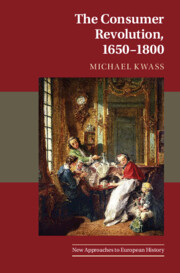Book contents
- The Consumer Revolution, 1650–1800
- New Approaches to European History
- The Consumer Revolution, 1650–1800
- Copyright page
- Dedication
- Contents
- Illustrations
- Acknowledgments
- Abbreviations
- Introduction
- 1 Consumer Revolution
- 2 The Globalization of European Consumption
- 3 Going Shopping
- 4 The Cultural Meanings of Consumption
- 5 Consuming Enlightenment
- 6 The Luxury Debate
- 7 The Politics of Consumption in the Age of Revolution
- Conclusion
- Select Bibliography
- Index
Introduction
Published online by Cambridge University Press: 13 January 2022
- The Consumer Revolution, 1650–1800
- New Approaches to European History
- The Consumer Revolution, 1650–1800
- Copyright page
- Dedication
- Contents
- Illustrations
- Acknowledgments
- Abbreviations
- Introduction
- 1 Consumer Revolution
- 2 The Globalization of European Consumption
- 3 Going Shopping
- 4 The Cultural Meanings of Consumption
- 5 Consuming Enlightenment
- 6 The Luxury Debate
- 7 The Politics of Consumption in the Age of Revolution
- Conclusion
- Select Bibliography
- Index
Summary
This chapter traces the rise of consumer goods in Europe and its colonies between 1650 and 1800. Women and men consumed ever larger quantities of clothing, personal accessories, household furnishings, and colonial products. However, any claim that the growth of consumption was “revolutionary” must confront two powerful objections: (1) that there were strict social limits to the spread of new types of consumption; and (2) that the growth of consumption was less sudden than it appears, having roots in the urban life and court society of preceding centuries. Taking these objections seriously, the chapter argues that consumption grew most intensively among nobles, gentry, professionals, skilled artisans, and better-off farmers. Many peasants, unskilled laborers, migrants, and enslaved people were excluded from participating in the consumer boom. Consumption was also gendered, with women leading the way in the acquisition of clothing. In the Americas, where indigenous Americans, European-descended settlers, African-descended slaves, and free people of color interacted, heterogeneous forms of consumption proliferated. The hybridity of sartorial culture reflected degrees of agency and self-fashioning among different socioracialized groups. The growth of towns and the advent of royal courts had encouraged new forms of consumption before 1650, but Europe experienced a more thoroughgoing social transformation in the late seventeenth and eighteenth centuries. The volume of goods increased, their variety widened, and their social reach deepened.
Keywords
- Type
- Chapter
- Information
- The Consumer Revolution, 1650–1800 , pp. 1 - 15Publisher: Cambridge University PressPrint publication year: 2022

